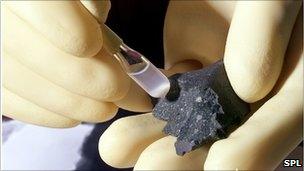'Life chemicals' may have formed around far-flung star
- Published

Meteorites tend to contain an excess of left-handed amino acids
There is now even more evidence that life on Earth may have been seeded by material from asteroids or comets.
Prior research has shown how amino acids - the building blocks of life - could form elsewhere in the cosmos.
These molecules can form in two versions, but life on Earth exclusively uses just one of them.
Now an Astrophysical Journal Letters paper, external shows how conditions around a far-flung star could favour the formation of one type over another.
Amino acids are corkscrew-shaped molecules that can form twisted to the left or right, and chemistry does not inherently favour one corkscrew direction over another. But with very few exceptions, life on Earth makes use of the left-handed version.
A famous experiment in 1952 showed, external how a spark across a soup of simple chemicals representing the primordial Earth could form amino acids - but like many that followed, it formed equal numbers of left- and right-handed types.
The idea that amino acids might have been delivered to the early Earth by meteorites - themselves formed from asteroids or comets - provided another route, and studies of meteorites have even shown, external excesses of left-handed amino acids.
Last week, Nasa astrobiologist Daniel Glavin and his colleagues followed up on that finding, saying their research showed, external that a wide variety of meteor types might play host to excesses of this sort.
What remained was to determine the mechanism by which the left-handed version could be preferentially produced in the cosmos, to be picked up and ultimately delivered to Earth.
Circular argument
Now, Uwe Meierhenrich of University of Nice Sophia Antipolis and colleagues have found one way that this "symmetry breaking" may happen.
They started with chunks of icy material that included several simple molecules: water, methanol, and ammonia - ingredients from which amino acids can be made.
They then exposed the ices to ultraviolet light of a very particular type.
Light has a polarisation, which is to say that light rays oscillate along a given direction - say, up and down, or left and right. While we can't see this effect directly, it is apparent in polarising sunglasses, which block reflected light that tends to be polarised along the left-and-right direction.
The light used by the researchers, by contrast, was what is known as circularly polarised. Rather than along a single direction, the polarisation traces out a corkscrew shape.
Light in the regions around a forming star is known to become circularly polarised like this as it passes through vast clouds of dust grains that are aligned by magnetic fields.
The experiments showed that the circularly polarised light led to the formation of both left- and right-handed amino acids - but there were slightly over a percent more of the left-handed version.
That is the level of excess that Dr Glavin and his colleagues have found in meteorites found on Earth - and the mechanism is a compelling fact in the case for an extraterrestrial origin for Earth's first amino acids.
"This excess is pretty cool," Dr Glavin told BBC News.
"You've got to break the symmetry somehow, this is critical. But how do you break it? That's one of the most important questions: did life just randomly choose one type over another? It's starting to look like Nature helped a bit."
However, Dr Glavin noted that these molecules can swap their forms, and that an unequal mixture of the two types will settle out to an equal mixture in time, a process called racemisation.
"These are exactly the kinds of experiments we need to be doing but we do need to keep the big picture in mind," he said.
That is, he said, to further shore up the idea that life on Earth started with a delivery of extraterrestrial ingredients, it still remains to pin down the mechanism by which the unequal mixtures can be preserved for the long journey from far-flung stars.